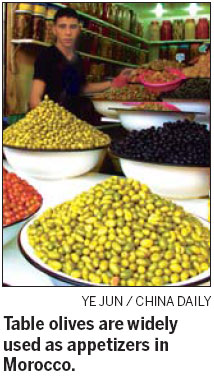Morocco eyeing Chinese market for its olives
Never before had I seen table olives packed so tightly in neat tapering piles as in the souks of Morocco, a country where olives are widely used as appetizers and served with herbs, such as thyme, rosemary and oregano.
An important player in the world's olive market, Morocco is the second largest producer of table olives and the sixth of olive oil.
A media tour organized by the International Olive Council (IOC) took me to the country's olive producing regions of Marrakech, Casablanca, Meknes and Fez. Marrakech specializes in table olives, while Meknes and Fez produce more olive oil.
According to Chaouki el Hassan, from Morocco's Ministry of Agriculture and Fisheries, the country produces 60,000 tons of table olives and 17,000 tons of olive oil every year.
One of the pillars of the national economy, olive cultivation and production employs 400,000 people.
Only a very small amount of chemicals is used in the cultivation, making Morocco's olives popular in the market, says Hassen Debbarh, from Interprolive, a federation of Morocco's olive producers.
Olive oil is best fresh, and all the farms I visited try to shorten the time between picking and crushing. At Atlas Olive Oils' Desert Farm at Elborou, near Marrakech at the foot of the Atlas mountain, a truck leaves every 20 minutes with freshly picked olives for crushing.
"It's the region's harsh environment that produces the quality olives," says Othmane Aqallal, the farm's managing director.

The young and handsome Moroccan belongs to the fourth generation of the Aqallal family in the olive business. While his farm boasts a 200,000 euro ($277,000) olive harvester, the majority of olive farms and mills are small, labor-intensive ones.
Making olive oil is an age-old tradition in Morocco. At the historic site of Volubilis near Meknes, the ruins of a Roman settlement, stands an ancient olive mill, evidence of the country's olive oil-making tradition, which dates back more than 2,000 years.
The major olive varieties in Morocco are the Picholine, an olive of both French and Moroccan origin, the Spanish Arbequina and Arbossana, as well as the Moroccan Dahbia and Greek Koroneiki.
The country is going in for high-density olive planting, of 1,000 olive trees per hectare, as against the norm of 100 trees per hectare.
Morocco hopes to double its production of olives by 2015 and double exports by 2018, according to Debbarh, of Interprolive.
Oualid A. Benjelloun, general manager of Blackbill Group, which represents Atlas Olive Oils in Shanghai, says the company is the only one in China selling Moroccan olive oil. But they don't yet sell Moroccan table olives.
"We introduced the brand in April 2010, and now distribute to over 25 five-star hotels, high-end restaurants and select retailers in Shanghai. Sales have been growing steadily," he says.
"In 2011, we'll distribute to other major cities, such as Beijing and Hong Kong."
China Daily
(China Daily 03/12/2011 page12)














